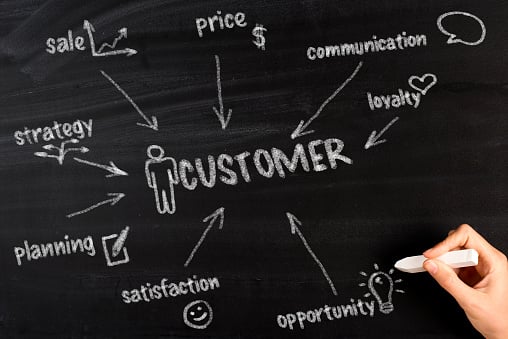
The A To Z Guide For Effective Sales Improvement In 2020 And Beyond
In The New Normal, Sales Execution Will Rule The Day – Are You Ready?
We’ve been talking about it for months. Innovative and proactive companies are reimagining and digitally transforming how they sell. Now is the time to look hard at your sales process, sales execution, sales team, sales metrics, reporting and more.
If you think the world is going to return to in-person sales calls, networking, trade shows, events, lunches, office phones and entertaining prospects, guess again.
Sales is never going to be the same as it was in January. You have to adopt a new way to think about sales, marketing, customer service and how you grow revenue, or consider much lower-than-expected growth for the next few years at least.
We’ve collected the ultimate list from A to Z of sales improvements, sales process upgrades and sales recommendations to move your sales team into the new normal.
Here you go.
Always Stick To The Process
Like it or not, sales is a process. It’s process that has to be documented, shared, enforced, iterated on and measured. If you’re not doing even one of these tasks, you don’t have an active sales process.
Create a process, then map it. We prefer to document the process visually and share it with everyone in the company who has any contact with the sales team.
The process map should have every touch point, email, phone call, social connect, virtual call and in-person meeting. It should include the expected timing between calls, and this entire process should be represented in your CRM so your sales process can be tracked, measured and reported on.
And yes, it must be mandatory. No sales rep should be allowed to lone wolf it anymore. Everyone follows the same process all the time – no exceptions.
Be Aligned With Marketing
The old-school days where marketing and sales constantly feud are over. Sales and marketing alignment isn’t optional anymore.
If marketing and sales don’t report to the same person, they should. But if they don’t, get those two executives together and create shared goals for both teams.
Put the two teams together, even if you’re remote now. Create shared chat rooms, run virtual meetings together, create shared goals and make sure both teams are compensated around the shared revenue metrics for the company.
You might even consider creating an SLA to keep everything tight and running smoothly.
Co-Create The Solutions
People generally don’t like surprises, and prospects are no different. In most cases, you’re selling to buying groups of five to seven people. It’s difficult to get all of them on the same page.
But by co-creating your recommended solutions and by including steps in your sales process where you socialize your recommendations, gain buy-in from key stakeholders and get their confirmation on your suggestions up front, you can ensure you’re going into that final recommendations meeting with support for your ideas, pricing, timeline and more.
In essence, you’re preselling your recommendations and getting approval in advance.
This approach drives up close rates dramatically, in some cases by as much as 50%. Once you have this part of your process locked in, you’ll never submit a proposal before having sign-off from your key decision-makers.
Deliver Content In Context
Content has to be a huge part of your sales process. This includes educational content, written content, research, videos, podcasts, blog articles, infographics, webinar recordings, live events, playbooks and more.
While marketing is creating content, sales needs content too.
When prospects ask questions or bring up challenges, your sales reps have to be armed with content they can deliver to help prospects feel safe about working with your company.
Once sales uncovers a challenge, they need to respond with, “A few of our customers have had similar issues. Let me send you a playbook we created to help them with this challenge. Many of my customers have said the playbook was extremely helpful. I’ll email it right over, and we can continue our conversation after you get a chance to read it.”
The better prepared your reps are with content, the faster the sales cycle will execute and the higher your close rate will be. The more content you leverage in sales, the more likely you’ll be to exceed your goals.

Experience Is Everything
Disney gets it. The better the experience, the happier the guest. Sales needs to take a similar approach. You have to create an experience for all your prospects from click to close.
The better the experience, the higher the close rate, the more efficient the sales process, the shorter the sales cycle and the more average revenue per new client. All the metrics go up when the sales experience is remarkable.
We ask all of our prospects to give us a score at the end of our sales process. This feedback and data help us continue to make even small adjustments along the way to create a sales experience that allows us to differentiate our agency from other agencies.
Think out of the box. What can you send them? How do you tell your story in a remarkable way? How can you create a memory? What tone do you use in your communication? How involved is senior leadership? There are many, many ways to create a set of remarkable touches and a remarkable experience.
You need to do the same thing day in and day out.
Follow Playbooks
Getting salespeople to all work in the same way can be challenging. There are more reasons to not follow the process than there are to follow a process.
You have salespeople with different backgrounds, different levels of experience and different levels of success. Some have been with you for a long time and some for a short time. It’s best to throw that all out the window and treat everyone equally.
Create playbooks that salespeople can follow. Here’s how we do a discovery call. Here’s how we do a diagnostic call. Here are the emails we use and when to use them. Here’s our content library and here’s how to use content. Here are some videos to use. Here’s a playbook on creating your own videos. Here’s our playbook on lead scoring or replying to chat conversations from our website.
Yes, this might seem like a lot, but it will help you keep everyone on the same page, document your sales process and all of your executables, and ensure your sales team is thriving and not just surviving.
Guide Prospects, Don’t Sell Them
People don’t want to be sold. They have created a number of fences that actually keep sales out, including caller ID, email spam folders, ad blockers and more. No study, data or research informs us that people like to be sold to.
In fact, so much data shows people go out of their way to avoid sales that it can no longer be ignored. Stop selling and start guiding prospects through their buyer journey.
Your salespeople need to think of themselves as a Sherpa, someone who helps guide your prospects.
Don’t do that, do this instead. Consider taking this approach. Based on my experience, this generally works better for companies like yours.
The tone is completely different than traditional sales. Always be closing is long dead. Try to create a sales process that is a guided sales process. Think about how you would work with a party of 10 people to get them to the top of Mount Everest safely.
Apply it to how you would get a group of 10 prospects to sign your paperwork. How can you guide them along the way? How do you get them to trust you? How do you share your experience and knowledge with them to be helpful?
Help Prospects Feel Safe
Marketing is working hard to make that solid emotional connection with prospects. They’re publishing content, emailing prospects, inviting them to webinars, sharing videos and creating a great website experience. Then finally that prospect says, “I want to speak with someone from sales.”
Success! A sales-qualified lead!
But now that educational, guided and advisory experience has to continue. Actually, it has to start again. They trust the company, but now they’re meeting a new person (a sales rep), and they have to feel safe with him or her.
One of the best ways to make this transition smooth and gain that safety quickly is by giving the rep access to all the information, behaviors and prospect data that should exist in your CRM system.
The rep should not be getting on the Zoom video call and starting with, “So, what do you guys do? Where are you located? What are you interested in?”
Instead, start the conversation with, “I see you’ve been in business for 15 years. You’re the CEO. You have 15 sales reps and two people in your marketing department, and I see from your content activity with us that you’re interested in websites, SEO, content marketing and paid social media campaigns. Is that correct?”
They will immediately appreciate that they don’t have to go over all of that information again. They will see you’re prepared and professional. It’s like showing up at the doctor and they actually know you, your family, your condition, your treatment plan and your insurance. You just feel better and safer.
Initiate Lead Scoring
Not all leads are created equally. You don’t want sales reps spending time with people who are never going to become new customers. Better yet, you want sales reps spending most of their time with your best prospects and working on those great prospects first.
Adding a lead-scoring model helps you understand the quality of leads marketing is generating and it helps reps prioritize their activities.
Lead scoring is also a perpetual effort. A lead that scores 90 today could be a 96 tomorrow or an 80 by Wednesday, depending on their behavior and activities.
Your lead-scoring model needs to be built with demographic, psychographic and online behavioral data. More importantly, you need to know what activities are triggered by lead score values. What does the team do when a lead becomes a 90? What about when a lead moves from 90 to 80?
All of this needs to be thought out, documented, tested and adjusted over time. This is where an active sales operation function drives efficiency inside your sales effort.
Just Turn On Chat
Some visitors to your website are ready to talk to you right now. Turn on chat and enable them to connect with you and your sales team instantly.
These conversations accelerate sales activity by helping prospects get to know, like and trust your company.
You can do almost everything you do using a form with any chat tool that runs on your website. You can qualify, you can connect, you can share content and you can ask questions. Even better, you can do it instantly and move weeks of back and forth forward in a matter of minutes.
You can even automate a big part of the information collection and question answering with chat bots. If done right, these automated experiences can feel human and be very effective.
Chat has come a long way, and chat with conversational marketing needs to be part of every revenue growth program.
Know, Like And Trust
We’ve been talking around this concept a bit. Prospects need to feel safe with your sales team, and that means they know you, like you and trust you.
Know, like and trust are specific emotions. They’re feelings you have to work toward, but by setting up specific interactions and touches, you can move to having prospects know, like and trust you faster than leaving it to chance.
Experience sharing helps your prospects get to know your reps. Asking a lot of questions helps prospects like your reps. Giving a lot of helpful information gets prospects to trust your reps.
Keeping the human side of sales in mind helps you create specific touch points in your sales process where you’re working on know, like and trust.
Look For Revenue In Your Customer Base, Too
I mention it in the A to Z’s because it’s so frequently overlooked. Marketing teams are hunting for new marketing-qualified leads. Sales teams are hunting for sales-qualified leads. Who’s looking for revenue opportunities within your current customers?
Customers are usually the best place to look for new revenue. Your customers already know you, like you and trust you. They’ve already used your product and service to their satisfaction.
It makes sense for you to offer them new products and services or extensions and add-ons for their existing product or service.
They’ve already opted in to your communication. All lights are green, yet so many companies miss this easy opportunity to generate more revenue from current clients.
Measure New Sales Metrics
Traditional sales metrics have been pretty straightforward. For example, sales quota attainment by rep and sales vs. goals month over month. You either meet or exceed your goals, or you miss them. That’s it.
Today, you have to start looking at sales performance with an entirely new lens. A number of very relevant sales metrics should be distilled down into a dashboard. You should be looking at these metrics weekly and deriving insights from the performance of your metrics to create action plans that get executed monthly.
Not doing it like this? You’re missing out on an opportunity to create a revenue generation machine that produces results month over month for years to come.
Some of those metrics include pipeline velocity, number of referrals, revenue by lead source, sales cycle in days and close rate on sales opportunities.
Take a look at the new set of metrics progressive sales organizations are tracking to inform the upgrades and updates they make over time.
Nurtures Continue The Conversation
It’s not easy continuing the conversation with eight to 10 legitimate sales opportunities. What if you had 50 sales opportunities?
The only way to make sure that these people are in constant contact with you and your company is to set up automated nurture emails that are designed to give prospects a great experience while limiting the amount of admin work done by sales.
You’re going to want to set up these automated workflow emails based on the length of your sales cycle. The longer the sales cycle, the longer your nurture and the more distance between nurtures.
You’re going to want to set up these workflow emails based on the prospect’s buyer journey. You want your emails to proactively move prospects along and get them to signal to your sales team their intent along the way.
You’re going to want to write, set up the triggers, track and measure the impact these emails have on your sales team’s ability to move prospects through the sales cycle and eventually close them faster and more frequently.
Without these, you’re going to let your competitors slip into your prospect’s buyer journey and subvert your effort to be their trusted advisor and guide. Once the competitors get in there, everything is harder and takes longer.
Over-Architect Your Sales Process
Yes, over-architect it. That means you’re designing every single aspect. You’re thinking about every touch point, even the smallest ones, like the thank-you email after a demo.
By overthinking it, you’ll make sure to not miss a single touch point, no matter how insignificant.
This is going to ensure you create a more compelling experience, tell a tighter and more consistent story, use content effectively, make the sales reps more efficient and see exactly where in your process prospects are getting hung up.
Once you identify this, work harder on that part of the process. This approach is going to unlock significant revenue stuck in your pipeline and allow you to take a more scientific approach to month-over-month revenue growth.
Pain Has To Be Acute
We talked about prospects needing to feel safe to say yes, but they also need to have acute pain. If your prospects don’t have acute pain, they don’t need to decide and they don’t have to purchase anything.
Use your qualification techniques to dig into pain. I like to ask prospects how big of a priority the project is on a scale from one to 10, where 10 is the highest priority project in the company.
If it’s a three or four, their pain is not acute. If it’s a nine or 10, their pain is very acute. This usually informs how fast their buyer journey is moving and how quickly they’ll come to a decision.
There are some ways to help prospects feel more acute pain. But generally, I’ve always believed pain is very difficult to move. Help them feel safe with your company, and if their pain is acute, they’ll close in less than 30 days.
Questions Are Everything
The best way to get to know someone at a party is to ask them questions. Not only does it make them feel good, it also makes them feel safe, and it helps you learn about what they like and don’t like.
Questions are key in sales, too. The more you ask, the smarter you can be when it comes to advice and recommendations.
The more you ask, the more personalized your guidance. The more you ask, the better your understanding of pain, project priority, budget, decision-making authority, competing priorities, past experiences and more. The list is almost endless.
Questions unlock a ton in the sales process, and you’ll find that the questions change based on stages of the buyer journey. Prospects early in the buyer journey might ask questions that are higher level or even theoretical. For example: How can an agency help us hit our revenue goals?
Prospects later in the buyer journey are going to ask more detailed and specific questions. For example: When can you get the engagement started? Who will I be working with?
Knowing these questions allows sales to be ready with additional questions, content and answers that help prospects feel safe and ready to say yes.

Response Time Is Key
If you’ve been following along, you know we’re advising to document a very specific process in detail. This means detailing expected response times, too. What is a reasonable time frame in which to reply to an email? What about a phone call or a chat request?
The faster, the better. But be specific, such as morning emails are replied to before noon, afternoon emails are replied to before you leave work for the day and emails that come in overnight are to be returned first thing in the morning.
Perhaps you want a similar window for voicemail messages, but chat could be even faster. Chat needs to be answered immediately, within a minute of coming in, and either routed to the correct assigned rep or handled by whoever is manning the chat tool that day.
In almost every case, the faster and more responsive, the better the experience for the prospect. Document, train and test your defined expectations on a regular basis.
Stories Makes It Emotional
Words matter, and you need a compelling, disruptive and emotional story to truly grow.
You need your reps to tell the same story in the same way over and over again. I’ve been on calls with reps and the CEO doesn’t even recognize their business based on how the reps are describing it. That has to change.
Spend the time coming up with an emotional story. Train your reps on how to tell the story. Reward them for telling it in a way that gets prospects to notice.
Ask them publicly to tell your story. Help them tell it in an emotional way. Make sure it’s disruptive enough to get a prospect’s attention, and if you don’t have the right story, go back to the drawing board and keep working on it until it’s ready for prime time.
Technology Makes It All So Much Easier
Ten years ago, you could run a sales organization with brute force, solid sales coaching, attention to detail and grit. Today, this will never work. It’s too complicated.
Today, you need strategy for your sales process, tactics for the execution, analytics to keep track of what’s working and technology to make the entire effort easier and more efficient.
You need sales and marketing technology that is designed to support today’s more complex sales execution.
You need a CRM that is flexible to fit any sales process you design, and you need that CRM to have the tools necessary to deliver a remarkable sales experience. You also need a CRM that provides the analytics required and one that connects with any additional tools you might need to deliver a remarkable and efficient sales experience.
You simply can’t execute efficiently without sales technology that is seamlessly connected to marketing tech and customer service tech.
Use Cases Help Sales Understand Prospects Better
You might not know what use cases are. They’re usually used when it comes to software features. What would the software users be doing with this feature? What problem does this feature solve for our users? Those are use cases.
Use cases in sales are similar. By understanding the challenges, issues, pains and problems your prospects are having, you can create stories that help them understand your ability to solve those pains.
Here’s a simple illustration.
CEOs don’t want to wait for marketing to work. They want leads and sales opportunities as fast as possible. The use case is about executives needing leads fast.
Our solution is the Accelerated Engagement. We’ll give clients a dedicated team and produce six months of work in just 30 days. Either use a fractional team for six months and wait for results, or hire our dedicated team and get results in 30 days.
It’s a simple, compelling, disruptive and emotional story that solves a use case for our prospects.
By understanding as many use cases as possible, reps can be better equipped to tell the right story, use the right words and support those stories with content. This shortens sales cycles and increases close rates every time.
Value Ongoing Training
Sales training used to come in packages provided by sales consultants. Each quarter companies brought the reps in and had in-office training on closing, questioning, following up, objection handling, etc.
That old-school training approach should be over.
Today, you want to train your reps weekly. You want to role-play storytelling. Train them on how to use content in context. Work with them on understanding your playbooks, evaluating lead scoring for prospects and determining which actions are attached to what scores. Teach them how to use new tools, like embedding video in emails.
If you do a little each week, you’ll start creating a continuous learning environment where reps are constantly getting better and constantly looking to learn something new.
These small bite-sized training sessions where practical application can come the same day are also going to be more effective at changing their behaviors than large scale, multi-day, in-office training like you used to do.
Everything’s changed. Change your approach to training, too.
Watch Metrics Daily, Weekly, Monthly And Quarterly
Sales has always been a very binary metrics-based function. Sales against the monthly goal. Reps’ quota attainment against their monthly goals.
But today there are so many different metrics to track that you need to watch the numbers daily, weekly, monthly and quarterly.
Numbers that might be worth watching daily include the number of chats assigned to each rep and the conversion rate on those chat requests as well as the number of sales-qualified leads assigned to each rep and the conversion rate on those to sales opportunities. Both of these numbers illustrate daily efficiency, and if those numbers are low, you want to know sooner rather than later.
Weekly numbers would include pipeline velocity, the number of new sales opportunities added to the pipeline by rep, MQLs and SQLs generated by marketing, the value of those leads and perhaps even sales cycle in days on a weekly basis.
The rest of the numbers would be monitored monthly, with a regular meeting to review the numbers, identify insights and come up with a monthly action plan to drive improved performance.
This cycle is usually new for sales teams, so settling into regular metric review meetings and coming out of every meeting with a set of action plans to improve performance is going to ensure you’re using data to improve results and business outcomes.

X-ray Vision Helps Uncover Unrealized Pains
Look, X is a hard letter to come up with something for, but uncovering hidden pains by using X-ray vision is important in sales.
Very often prospects will tell you there are no issues in a particular area, and as an advanced guide your role is to ask more questions and push to uncover hidden issues or challenges.
If you can talk about the symptoms your prospect is experiencing, you might be able to trace those symptoms back to a root cause, diagnose the cause and then start talking about solutions that fix the issue where it is being triggered.
This is a skill that adds a lot of value, helps prospects quickly trust you and builds long-term relationships with customers.
You Have To Put Yourself In Their Shoes
This is a skill that the best salespeople do naturally. They think about how they would feel if they were dealing with everything their prospect is currently dealing with.
They’re then able to create a set of solutions that they’d want and share those with the prospect. At Square 2, it’s a bit of a superpower for us. It helps us empathize with our clients’ prospects and helps us create stories that resonate with their prospects.
The better your reps are at thinking like the prospect, the better they’ll be at closing business for you.
Zoom Is Your Friend
Thank goodness for Zoom. But yes, use Zoom or any other video conferencing technology to remove the need for in-person meetings. Even if you want to travel and your company is approving travel, visiting your prospects is going to be problematic for many months to come.
Instead, get good at video meetings.
Get the lighting right, get the sound right, remember to ask good questions and act professional. Do your best to eliminate distractions, even when that might be impossible.
Consider your background. Making remarkable backgrounds is a great way to get the meeting off on a nice casual footing. Remember, you need them to know, like and trust you. Anything you can do within Zoom is going to help you get there.
Recording calls is an excellent training tool, but remember to ask permission before you record. Also, consider where you’re storing your recordings. Cloud recordings can quickly use up your allocated space and you could incur additional fees.
Recording locally might make access for review and training more problematic.
This is another place where role-play and ongoing training make a big difference. The more Zoom calls you do, the more comfortable your team will be, which means the more effective they’ll be talking to prospects.
Today, Zoom and video conference calling is the norm. Lean into this and make sure it stays that way for your organization. Your prospects are going to appreciate it, and it’s going to allow your sales team to be much more efficient and much more effective.
It’s going to allow you to monitor and support your new sales process in a way you’ve never been able to do before. Take full advantage of it.
There is a lot here with 26 ways to improve sales performance.
You don’t have to do them all tomorrow. Pick and choose those that will have the biggest impact and take the least amount of effort. Start there. Work your way through the list and get help if you need it. Plenty of consultants and sales enablement agencies can provide guidance around some or all of the recommendations in this list.
What’s important is that you constantly work to drive measured improvements against a documented and required sales process. That is the most important part of this list. Do that and you’ll already be ahead of 80% of the sales teams out there today.

CEO and Chief Revenue Scientist
Mike Lieberman, CEO and Chief Revenue Scientist
Eliminate Hit-or-Miss Marketing Moves
Get advice, tips, tools and guidance to generate more leads for your company in this weekly email newsletter.



Eliminate Hit-or-Miss Marketing Moves
Get advice, tips, tools and guidance to generate more leads for your company in this weekly email newsletter.















